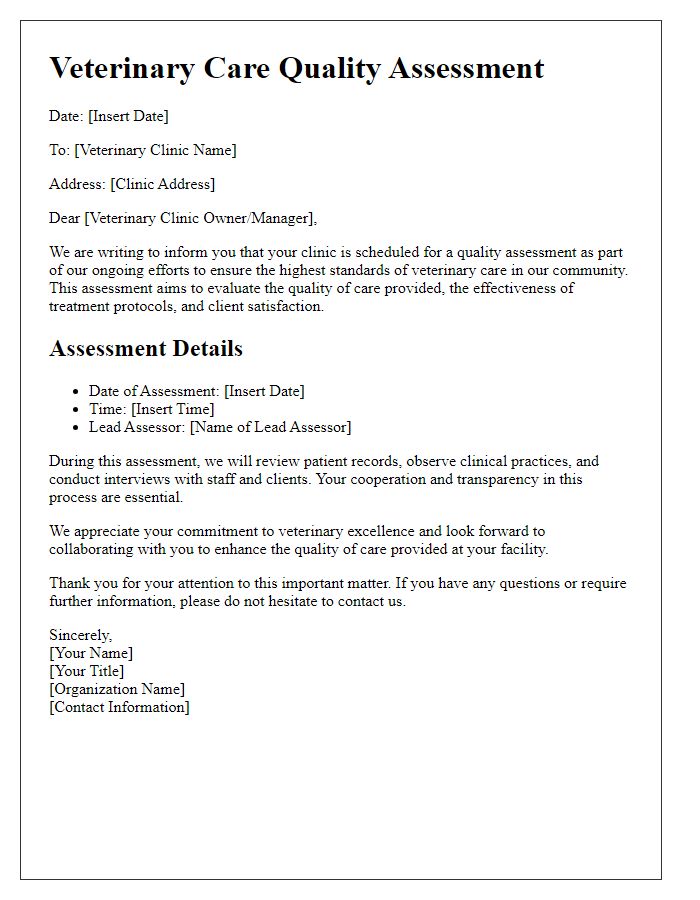Are you ready to take a closer look at the welfare of our beloved animals? Conducting an animal welfare audit can be a game changer, helping organizations ensure that they meet the highest standards of care and compassion. This process not only promotes transparency but also fosters trust within the community. So, let's dive in and discover how an effective audit can make a difference for animals everywhereâread on to learn more!

Purpose of Audit
The purpose of the animal welfare audit is to evaluate the living conditions, treatment, and overall well-being of animals in various settings, such as farms, shelters, and research facilities. This comprehensive assessment aims to identify compliance with established welfare standards, which may include the Five Freedoms framework, emphasizing freedom from hunger and thirst, discomfort, pain, injury, or disease, and the ability to engage in natural behaviors. The audit examines facilities' practices and policies, evaluating factors like space, social interaction, veterinary care, and enrichment opportunities. This process ensures adherence to local, national, and international regulations, promoting ethical practices that safeguard animal welfare across multiple sectors. Ultimately, the audit's findings contribute to enhancing the quality of life for animals and fostering public trust in organizations committed to humane treatment.
Scope of Assessment
The scope of assessment for an animal welfare audit encompasses multiple dimensions of care, housing, and overall treatment of animals housed within facilities such as shelters, zoos, and farms. This evaluation includes examining living conditions, dietary standards, veterinary care, and behavioral enrichment practices to ensure compliance with established welfare guidelines. Specific attention focuses on animal species diversity present, which may include domesticated animals like dogs and cats in shelters, as well as exotic species like elephants and lions in zoos. Assessors will review adherence to laws such as the Animal Welfare Act of 1966 in the United States, high standards set by the World Animal Protection organization, and regional legislation. The analysis will also involve direct observation of animal handling practices by caretakers to determine levels of human-animal interaction, training methodologies, and stress indicators among the animals. Findings from this assessment are essential for improving welfare conditions and implementing corrective actions in accordance with best practices.
Compliance Standards
Animal welfare audits assess adherence to established compliance standards, ensuring humane treatment and care of animals in various settings such as farms, shelters, and research facilities. Key performance indicators (KPIs) include acceptable living conditions, access to food and clean water, and provision of appropriate veterinary care. Notable guidelines, like those from the World Organisation for Animal Health (OIE) and the American Veterinary Medical Association (AVMA), outline specific requirements regarding the ethical treatment of animals. Auditors typically evaluate aspects such as space allocations per animal, enrichment strategies to enhance well-being, and protocols for stress reduction. Compliance with local legislation, such as the Animal Welfare Act in the United States, is also critically analyzed to identify areas of risk and non-compliance. Comprehensive reports generated post-audit offer insights for improvement, ensuring that animals receive proper care and ethical treatment across institutions.
Observation Results
In an animal welfare audit at the Greenfield Farm located in Oregon, several key observations were recorded regarding the treatment and living conditions of the livestock. The cattle, specifically Angus and Hereford breeds, were noted to have access to clean water and pasture grazing areas, adhering to humane standards. However, records indicated a lack of regular veterinary check-ups, with only 40% (less than the recommended 80%) receiving timely vaccinations to prevent common diseases like bovine respiratory disease. The housing structures for pigs showed insufficient ventilation, leading to elevated humidity levels, approximately 75%, which could pose health risks. Additionally, the enclosure size for poultry, specifically broilers, did not meet the Welfare Code guidelines, with only 0.05 square meters per bird compared to the recommended 0.1 square meters. Overall, while some aspects of animal welfare were satisfactory, critical areas require immediate attention to enhance the well-being of the animals on the farm.
Recommendations for Improvement
The animal welfare audit for the XYZ Animal Shelter highlights several essential recommendations aimed at enhancing the overall well-being of the resident animals, including dogs, cats, and small mammals. Implementation of a structured enrichment program, featuring daily physical exercise and mental stimulation activities, can significantly improve the psychological well-being of the animals, reducing stress levels. Upgrading enclosures to comply with the standards set by the American Society for the Prevention of Cruelty to Animals (ASPCA) will ensure adequate space and comfort for each animal. Training staff in proper handling techniques, documented by the Humane Society of the United States, can promote safer interactions and reduce anxiety during adoption events. Additionally, routine health assessments, incorporating vaccinations, parasite control, and spay/neuter programs, are crucial for preventing disease and ensuring the animals' long-term adoption success. Regular staff meetings to discuss animal welfare standards and strategies can foster a more cohesive environment committed to improving each animal's life in the shelter.













Comments